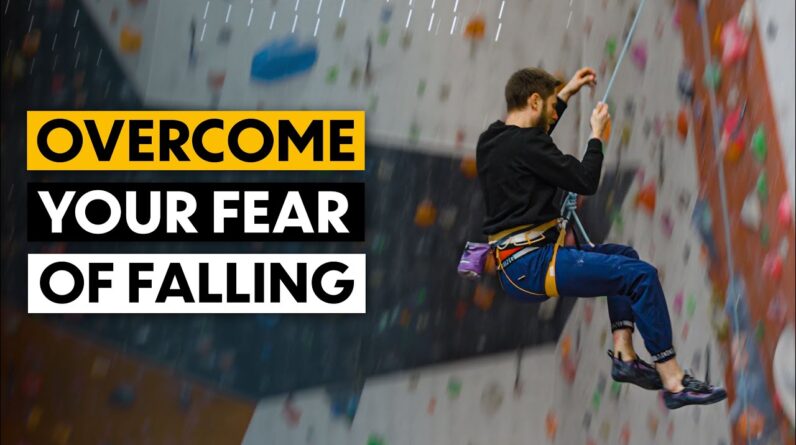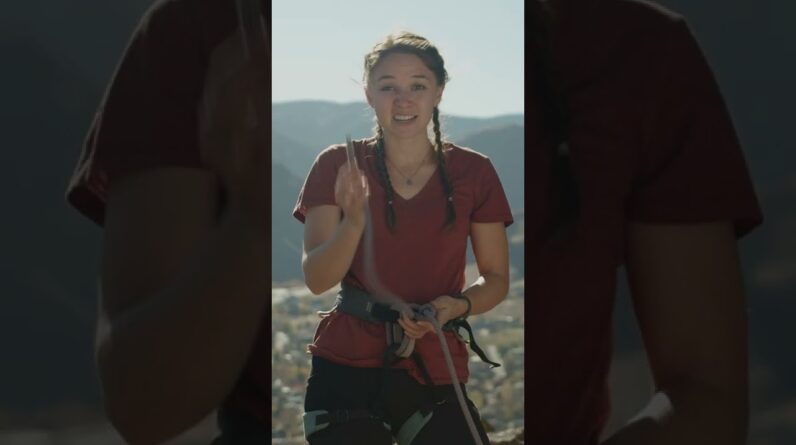
Fear of falling affects everyone, even the pros. If you climb with a rope you need to watch this video. If you don’t, you still need to watch this video because it applies to bouldering too! We’re talking about the science of fear!
We first need to understand what happens to the body when we experience fear so that we can best take control of these processes. Cue the fight or flight response!
Fight or Flight is a fear response – As soon as you anticipate a dangerous situation your amygdala gets to work and triggers the sympathetic nervous system, signals are sent out to release ‘stress hormones’, like adrenaline. These kick the body into high gear, so it becomes tense and alert. Some can be good but too much is not a good thing. It will become difficult to focus on small tasks since your brain is preoccupied with the fear.
However, the brain also releases dopamine during the fight or flight response. Dopamine is a neurotransmitter “chemical messenger” that plays a role in how we feel pleasure. So when the fearful situation does not become overwhelming or traumatic we can end up enjoying the experience. This is why we like roller coasters and watching scary movies.
Controlling the situation to manage the dose and frequency of fear we can start to overcome our fear of falling. We also discuss how counterfactual thinking, visualisation, self-talk and ego play a big role in the journey to overcoming fear.
Fear affects everyone even pro climbers However over time we can control the Amount of fear we feel with training Today we’re going to awesome sheffield To talk about the most common fear in Climbing that is the fear of falling We’re also going to give you some Practical methods and tips for expanding Your comfort zone and overcoming your Fear of falling [Music] We first need to start by understanding What fear is and how this works in our Body so we’re going to talk about the Science of fear in most cases taking a Lead fall is perfectly safe and you Shouldn’t be that afraid of this Situation you may be innately fearful of Being at height or the sensation of Falling however when we’re on a rope We’re tied in we’re controlling the Situation and therefore high levels of Fear is irrational and will hold you Back from your performance in climbing Anxieties are often learned through Association so you were likely not born With a fear of taking a lead fall but Rather at some point you decided that This was something you needed to be Afraid of to protect yourself one Example would be on your first ever Climbing trip you saw people taking big Lead falls and decided that looked Really scary and was something you would
Not try doing yourself Or maybe you were fine with falling in The first place but at some point you Took a really big or scary fall and that Was a traumatic event for you and Therefore you decided you don’t ever Want to do that again either way your Brain has made connections between Falling and something you would like to Avoid at all costs on a conscious level You may know that a small fall is Completely harmless but your brain has a Clever way of taking the reins and Steering you away from these situations Cue the fight or flight response fight Or flight is your fear response as soon As you anticipate a dangerous situation This response kicks in in a part of the Brain called the amygdala this triggers Your sympathetic nervous system and Signals are sent out to release stress Hormones like adrenaline your body is Kicked into high gear and you become Tense and alert a little bit of this can Be a good thing but a lot is definitely Not a good thing it becomes really Difficult to focus as your brain becomes Preoccupied with fear what is important To note at this point is you may not Have actually done anything which felt Dangerous in the first place your brain Is simply making predictions about what Might happen in the future this happens In the same way that that famous study
Where pavlov was able to make his dog Salivate at the ring of a bell however Pavlov was also able to make the dog Stop salivating after the bell using a Technique called fear extinction fear Extinction is defined as a lessening of Conditioned fear following extinction Training essentially this is done by Repeatedly removing the outcome which They have learnt to predict so you might Be starting to see how about changing The environment can overcome fear However here’s the tricky part the fear Response triggered by your fear is Enough to justify the fear itself that’s Because the physiological processes that Follow things like adrenaline flooding Our system are unpleasant and draining Things like a faster heart rate tensing Up feeling sweaty feeling panicky all of These things are really unpleasant and So therefore your brain decides the last Time we did that was really bad this is Unfortunately enough to form a negative Feedback loop and the worse the Experience the more potent the fight or Flight response can be the next time so Bad experiences can reinforce your fear Or potentially even make it worse However there is a way out a way to hack The brain and this is because during Flight or flight response our brain also Releases dopamine a chemical transmitter Which is involved in our feeling of
Pleasure so when a fearful situation Does not become overwhelming or Traumatic we can actually end up Enjoying that experience in the same way That we enjoy things like roller coaster Rides or watching scary films now we can Start to see how small doses of fear can Actually be used to expand our comfort Zones and start to break that negative Feedback loop that comes with fear Itself two things are really important For expanding our comfort zone the first Is repetitively exposing yourselves Towards your fear without any negative Outcome in that situation the second is Make sure you control the dose of that Fight or flight response so that it does Not go over the top and become traumatic But it is enough to leave you excited And enjoying this situation if we’re Taking climbing falls we need to Remember the intention of that session Is to reduce our anxiety finding that Sweet spot in between being too scary And not being enough to trigger a little Bit of fight or flight another important Thing to remember is that fight or Flight is hard or fatiguing on your body So when we talk about limiting the dose Also think about limiting the time of Your session or the amount of times you Take a fall your brain has a way of Dwelling on negative outcomes that may Never have happened or are unlikely to
Happen if you’ve ever stood next to a Cliff and imagined what it would be like To throw yourself off this is called Counterfactual thinking counterfactual Thinking essentially is a negative form Of visualization and has power to hijack Your emotions and response to fear this Is what’s happening if you’re imagining The worst case scenario of taking a lead Fall before you’ve even tied in you Should try to take control of this with Positive visualizations and thinking of The best outcomes in this situation for Example your favorite be layer giving You the perfect soft catch or maybe not Falling at all and sending your route Counter factual thinking might also Allude to what scares you the most so in A lead climbing situation Are you thinking about the gear failing Are you thinking about taking a hard Fall Use this to practice specifically on What scares you the most for example Sitting on your gear or getting your b Layer to give you plenty of soft catches So that you overcome that specific fear Your working memory works best through Speech and this is where it is thought Your inner monologue comes from so using Your inner monologue To generate positive self-talk can have A big impact on your courage and Confidence use positive self-talk to try
And build positive emotions around What’s holding you back most so like Earlier where we talked about the gear Or is it your b layer try and generate Positive thoughts about good outcomes Specific to these situations to overcome Fear it is important to accept the fear And release your ego one extreme is Hiding fear and not wanting to show Weakness in front of your peers Therefore you might end up putting Yourself in really scary situations and Constantly being forced into that Negative feedback loop the other extreme Is accepting the fear and never pushing Past your comfort zone leading to a Fixed mindset ego also plays a role in Fear of failure and not wanting to fall Off easy routes therefore you tend to Always stay within your comfort zone and Only climb things well within your Ability one of the best tactics for Releasing your ego is being open with People and telling people where you’re Afraid and what you want to overcome in Your climbing this segues really nicely Into my next point which is climbing Partners climbing partners can make a Massive difference to your process of Overcoming your fear of falling and Provide a lot of support here is a Really simple four-part checklist for a Good climbing partner for overcoming Fear of falling someone you can be open
And honest with about your fear of Falling someone that understands the Process and what you’re trying to do to Overcome that fear someone that won’t Shout things that push you too far out Of your comfort zone like just go higher Don’t be aware But we’ll also give you words of Confidence when you are climbing well Jen you got this come on jen you got it Someone that can give you a good spot or A soft catch try not to shout take when You’re climbing this only shows you are Not focusing on the climb itself and the Act of shouting in panic can just make You panic even more however the aim of Full practice is to reduce your anxiety So if limiting communication with your Belayer increases your anxiety try to Keep some form of communication Throughout the process however just try To keep your voice calm and say things Like watch me hear rather than shouting As you’re falling a caveat to all of the Points mentioned previously is everyone Is individual so everyone will be Starting with a different level of fear And also will be going through the Process At their own speed as well as using Their own preferred tactics for Improving their confidence a common Question we get is how often should i Complete full practice and the answer to
This is definitely it depends think of The brain like a muscle it needs to be Stimulated repetitively and continuously To adapt but also if we stop giving it a Stimulus it will also start to lose Those gains if you naturally feel more Comfortable on a rope then you will Likely have to perform this kind of full Practice less often and then if this is A bigger limiting factor for you then More often and potentially for a more Extended period is more important for Your training if fear of falling is Seriously holding you back in your Performance it’s probably a good Recommendation to perform for practice Year round making sure that you’re Really overcoming this fear however like We said earlier if you’re more Comfortable a short stint perhaps a Month before a climbing trip might be Enough to really help you perform better Start with simply bouncing and swinging Around on a rope you’re trying to get Comfortable in this situation and not Feeling tense try and relax and feel Comfortable once you’re comfortable with This you’re going to take small falls on Top rope so this means falling into the Slack in the rope try to focus on calm Breathing and being relaxed if you’re Feeling overly tense at any point this Might be a sign that you’re moving Slightly too fast in the process we’re
Going to start by climbing bolt to bolt And sitting at each bolt and then Bouncing around on the rope really Getting comfortable with the equipment And sitting in the harness from here We’re gradually going to expand our Comfort zone with the falls we are Comfortable taking the first step is Clipping the quick draw and then Immediately sitting into the fall Next is taking the clip making a move And then falling And finally taking a fall with your Waist above the quick draw again focus On breathing and try and relax thinking About relaxing the muscles in your face And shoulders the final step is linking Performance to full practice where Falling is highly likely in this Situation but you try to concentrate on The climbing itself and not the falling Try to focus on the rhythm of your Breath the flow of your movement and Again relaxing where you can Try to use hard but well-known routes That you can really focus on your Emotions and also your movement think of This as hyper-focused climbing practice Put all of your attention into the Movement even the texture of the holds As you’re climbing and in this way you Should release the attention from your Fear of falling if you’ve had any really Good tactics help you improve your fear
Of falling please let us know in the Comments below i hope you enjoyed this Video and we’ll see you next time






